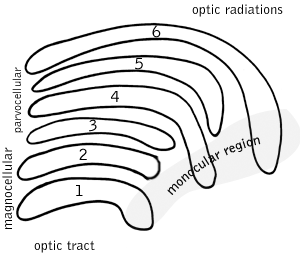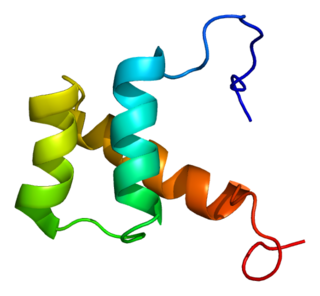
The retina is the innermost, light-sensitive layer of tissue of the eye of most vertebrates and some molluscs. The optics of the eye create a focused two-dimensional image of the visual world on the retina, which then processes that image within the retina and sends nerve impulses along the optic nerve to the visual cortex to create visual perception. The retina serves a function which is in many ways analogous to that of the film or image sensor in a camera.
Dolby Digital, originally synonymous with Dolby AC-3, is the name for a family of audio compression technologies developed by Dolby Laboratories. Called Dolby Stereo Digital until 1995, it is lossy compression. The first use of Dolby Digital was to provide digital sound in cinemas from 35 mm film prints. It has since also been used for TV broadcast, radio broadcast via satellite, digital video streaming, DVDs, Blu-ray discs and game consoles.

The visual system comprises the sensory organ and parts of the central nervous system which gives organisms the sense of sight as well as enabling the formation of several non-image photo response functions. It detects and interprets information from the optical spectrum perceptible to that species to "build a representation" of the surrounding environment. The visual system carries out a number of complex tasks, including the reception of light and the formation of monocular neural representations, colour vision, the neural mechanisms underlying stereopsis and assessment of distances to and between objects, the identification of a particular object of interest, motion perception, the analysis and integration of visual information, pattern recognition, accurate motor coordination under visual guidance, and more. The neuropsychological side of visual information processing is known as visual perception, an abnormality of which is called visual impairment, and a complete absence of which is called blindness. Non-image forming visual functions, independent of visual perception, include the pupillary light reflex and circadian photoentrainment.

Dolby Laboratories, Inc. is a company specializing in audio noise reduction, audio encoding/compression, spatial audio, and HDR imaging. Dolby licenses its technologies to consumer electronics manufacturers.

5.1 surround sound is the common name for surround sound audio systems. 5.1 is the most commonly used layout in home theatres. It uses five full bandwidth channels and one low-frequency effects channel. Dolby Digital, Dolby Pro Logic II, DTS, SDDS, and THX are all common 5.1 systems. 5.1 is also the standard surround sound audio component of digital broadcast and music.

Walter Scott Murch is an American film editor, director, writer and sound designer. With a career stretching back to 1969, including work on THX 1138, Apocalypse Now, The Godfather I, II, and III, American Graffiti, The Conversation, Ghost and The English Patient, with three Academy Award wins.

A receptor antagonist is a type of receptor ligand or drug that blocks or dampens a biological response by binding to and blocking a receptor rather than activating it like an agonist. Antagonist drugs interfere in the natural operation of receptor proteins. They are sometimes called blockers; examples include alpha blockers, beta blockers, and calcium channel blockers. In pharmacology, antagonists have affinity but no efficacy for their cognate receptors, and binding will disrupt the interaction and inhibit the function of an agonist or inverse agonist at receptors. Antagonists mediate their effects by binding to the active site or to the allosteric site on a receptor, or they may interact at unique binding sites not normally involved in the biological regulation of the receptor's activity. Antagonist activity may be reversible or irreversible depending on the longevity of the antagonist–receptor complex, which, in turn, depends on the nature of antagonist–receptor binding. The majority of drug antagonists achieve their potency by competing with endogenous ligands or substrates at structurally defined binding sites on receptors.

The fovea centralis is a small, central pit composed of closely packed cones in the eye. It is located in the center of the macula lutea of the retina.

Horizontal cells are the laterally interconnecting neurons having cell bodies in the inner nuclear layer of the retina of vertebrate eyes. They help integrate and regulate the input from multiple photoreceptor cells. Among their functions, horizontal cells are believed to be responsible for increasing contrast via lateral inhibition and adapting both to bright and dim light conditions. Horizontal cells provide inhibitory feedback to rod and cone photoreceptors. They are thought to be important for the antagonistic center-surround property of the receptive fields of many types of retinal ganglion cells.

A koniocellular cell is a neuron with a small cell body that is located in the koniocellular layer of the lateral geniculate nucleus (LGN) in primates, including humans.

Captodiame (INN), also known as captodiamine, is an antihistamine sold under the trade names Covatine, Covatix, and Suvren which is used as a sedative and anxiolytic. The structure is related to diphenhydramine.

Integrin alpha-IIb is a protein that in humans is encoded by the ITGA2B gene. ITGA2B, also known as CD41, encodes integrin alpha chain 2b. Integrins are heterodimeric integral membrane proteins composed of an alpha chain and a beta chain. Alpha chain 2b undergoes post-translational cleavage to yield disulfide-linked light and heavy chains that join with beta 3 to form a fibrinogen receptor expressed in platelets that plays a crucial role in coagulation. Mutations that interfere with this role result in thrombasthenia. At least 38 disease-causing mutations in this gene have been discovered. In addition to adhesion, integrins are known to participate in cell-surface mediated signalling.

Olfactory receptor 52D1 is a protein that in humans is encoded by the OR52D1 gene.

Homeobox protein DLX-2 is a protein that in humans is encoded by the DLX2 gene.

Homeobox protein Meis2 is a protein that in humans is encoded by the MEIS2 gene.

Neuronal acetylcholine receptor subunit alpha-9, also known as nAChRα9, is a protein that in humans is encoded by the CHRNA9 gene. The protein encoded by this gene is a subunit of certain nicotinic acetylcholine receptors (nAchR).

17-Phenylandrostenol (17-PA), or (3α,5α)-17-phenylandrost-16-en-3-ol, is a steroid drug which binds to GABAA receptors. It acts as an antagonist against the sedative effects of neuroactive steroids, but has little effect when administered by itself, and does not block the effects of benzodiazepines or barbiturates.

A parasol cell, sometimes called an M cell or M ganglion cell, is one type of retinal ganglion cell (RGC) located in the ganglion cell layer of the retina. These cells project to magnocellular cells in the lateral geniculate nucleus (LGN) as part of the magnocellular pathway in the visual system. They have large cell bodies as well as extensive branching dendrite networks and as such have large receptive fields. Relative to other RGCs, they have fast conduction velocities. While they do show clear center-surround antagonism, they receive no information about color. Parasol ganglion cells contribute information about the motion and depth of objects to the visual system.

The Gandhi Bhawan is a major landmark of the city of Chandigarh, India, and a center dedicated to the study of the words and works of Mohandas K. Gandhi. It was designed by architects B.P Mathur in collaboration with Pierre Jeanneret.

6β-Naltrexol, or 6β-hydroxynaltrexone, is a peripherally-selective opioid receptor antagonist related to naltrexone. It is a major active metabolite of naltrexone formed by hepatic dihydrodiol dehydrogenase enzymes. With naltrexone therapy, 6β-naltrexol is present at approximately 10- to 30-fold higher concentrations than naltrexone at steady state due to extensive first-pass metabolism of naltrexone into 6β-naltrexol. In addition to being an active metabolite of naltrexone, 6β-naltrexol was itself studied for the treatment of opioid-induced constipation. It was found to be effective and well-tolerated, and did not precipitate opioid withdrawal symptoms or interfere with opioid pain relief, but development was not further pursued.


















